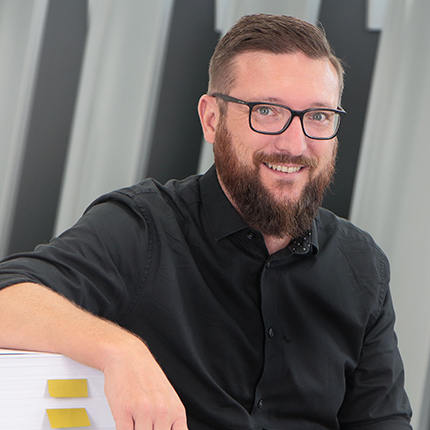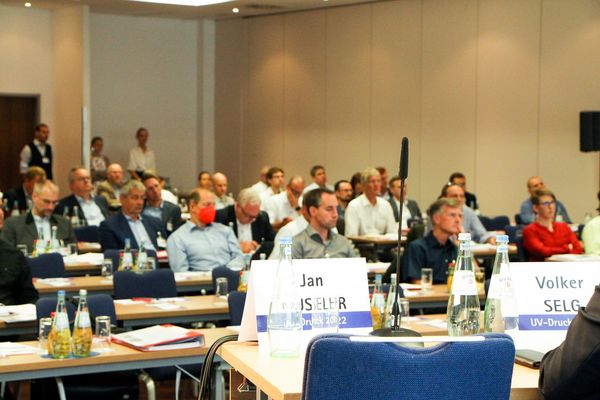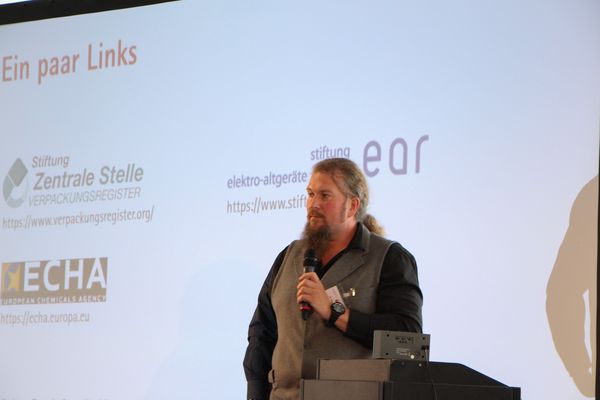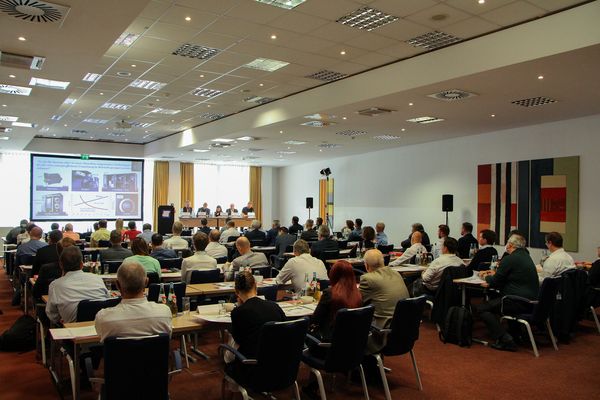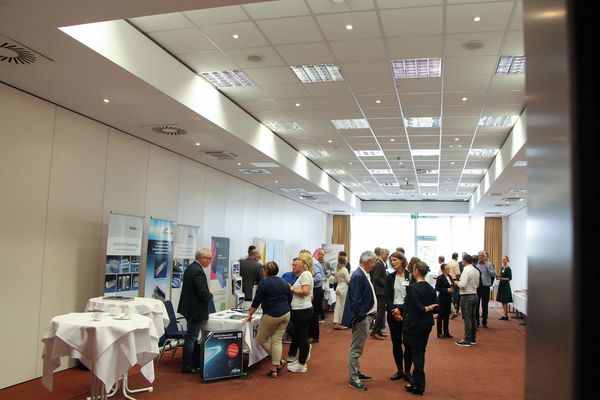Topic of your interest
12th Fogra user forum UV-Print
Material & Umwelt Press releases 09/08/2022
Four years after the last live user forum, around 70 people came together for the industry meeting at the beginning of September. Over two days the 17 topics revolved around safety and sustainability in UV printing, supplemented by reports from the field. The event was hosted by Dr Philipp Stolper, head of Fogra's Materials & Environment department.
Sustainability in UV printing
The topic was examined from very different angles in four presentations. A unifying element was the saving of energy and costs.
Martin Zibold from Heidelberger Druckmaschinen reported on how energy can be saved when printing with UV. Besides the influence on production costs, a contribution to sustainability is also made. Adjustments can be made to existing presses or new technologies can be used. Zibold emphasises that this conversion is associated with high costs and only leads to savings in the medium to long term.
Dr Gülara Krieger from the Fogra Research Institute explained how optimising UV lamps can reduce the energy consumption of printing presses. The basic prerequisite for this is to match the UV lamp and ink as precisely as possible. The savings can then be realised by reducing the power or number of lamps (in this case the end-of-press dryers). The application of the printed product is decisive here. If necessary, further investigations such as migration tests must be carried out.
Volker Selg from IST METZ presented the advantages of light curing using LED UV compared to thermal drying. This has already been used successfully for some time. This can extend the number of substrates that can be used or avoid the build-up of ink in downstream processes. Furthermore, the paper is not excessively dried and the need for silicone application is eliminated. Last but not least, this technology is not directly dependent on natural gas.
Sustainable printing is also possible in the field of metal decorating, as Jan Museler from the hubergroup Germany reported. The switch from thermally drying to UV-curing inks leads to cost and time savings in the production process. This trend is also reflected in the growing market share of radiation-curing inks.
UV technology? - Safe!
The issue of safety is still particularly important in UV printing. The seven speakers examined this aspect from different perspectives: on the one hand with regard to the protection of employees or end customers, and on the other with regard to production and environmental safety.
The Verband der deutschen Lack- und Druckfarbenindustrie examined the potential risk to consumers of UV-printed magazines. Kathrin Mohr showed the different test scenarios: The test of magazines with barely to completely cured UV ink. After the analytical tests were carried out, the toxicological evaluation followed. The result: the oral and dermal uptake was clearly below the hazard limit.
Beatrix Genest from the Saxon Institute for the Printing Industry then dealt with the question of how to control the degree of curing of UV prints. She first discussed various physical (e.g. scratch test, sliding friction measurement) and chemical (e.g. potassium per manganese test, wipe test with solvents) methods. Genest then presented the currently most reliable instrument, infrared spectroscopy, with all its pitfalls. It is currently considered the most effective method.
Safety for the customer also means that the recyclability of the products produced in the UV is given. Andreas Faul from INGEDE reported on several research projects of different institutes on this topic. These have contributed to significantly improving deinkability in recent years. The findings showed, for example, that among emitter types LE seems to perform worst. To raise the level of recyclability to that of conventional print products, however, there is still a need for further development, as Faul made clear.
Dr Uwe Bertholdt from Fogra explained the topic of standardisation in general and the ISO standards in particular. He underlined the resulting improvements in printing conditions. He also pointed out that there are currently no special and specific ISO standards for UV printing. However, printing in accordance with ISO 12647-2, for example, is possible in UV printing and is already common practice.
Reports from practice
In concrete examples the speakers reported from their respective everyday working life: on the one hand the challenges of colour changes, on the other hand, the use of UV printing at a heatset printing company and finally also how press manufacturers help with problems with curing.
The ever-advancing classifications of chemicals - especially photoinitiators - present companies with special challenges. Dr Joseph Adelsberger of the Schreiner Group showed the impact on a printing company that works mainly with UV-curable inks. The changeover in ink formulations meant that a large number of the more than 900 different inks, functional coatings and printing auxiliaries had to be requalified for special applications. This process takes up to three years and contrasts with the often much shorter deadlines for bans on chemicals.
With energy savings of 80 per cent, the Kyburz printing company's experience in converting from gas-fired heatset to LED dryers was very positive. The conversion took place in just a few steps: in addition to the dryers, the ink rollers and ink pumps had to be converted and the printing units prepared for UV technology, reported Carsten Barlebo of AMS Spectral UV, which accompanied the changeover.
Mariann Thutewohl from Koenig & Bauer showed how FT-IR spectroscopy can be used in the day-to-day work of printers. The method helps with new installations and process control, specifically with commissioning or reflector monitoring. Processes can be improved with the evaluation of the measurement results and lead to energy savings. But the method also provides support in the event of complaints. For example, the functionality of the UV lamp can be checked. In this context, it is important that the results do not stand alone, but must be put into perspective.
Dr Roland Perz from the Chemical and Veterinary Investigation Office CVUA Stuttgart looked at UV from a consumer protection perspective. He paid special attention to food contact materials (FCM) that are affected by migration. For example, substances that do not appear in the positive list of the Consumer Goods Regulations (BedGgstV) were found in sheep's cheese in foil packaging, motif napkins and bicycle drinking bottles. But his positive conclusion: The objection rate at FCM regarding printing ink components is below 5 per cent.
To ensure the safety of radiated power, Jörg Hannig, Excelitas Technologies, recommends measuring during operation. This results in permanent process monitoring (contamination, failures or ageing are detected), which reduces restrictions in production. Macule can also be prevented and quality assured.
The importance of safety in the press room was reported by Dr Axel Mayer of the association ETEM. The special features of UV printing relate to skin and respiratory hazards from UV inks and varnishes, radiation sources, but also UV washing and cleaning agents. Dr Mayer states that in the meantime a very high standard is maintained in the printing plants. This is reflected in the fact that skin diseases and occupational accidents are on the decline.
Consumables
The two presentations dealt with low-migration inks in UV printing and regulatory requirements. They added to the points already made in other papers under the heading of safety.
The migration of UV inks must be reduced, especially in the case of food contact materials (FCM). Dr Jochen Schneider from Zeller+Gmelin explained clearly the key points to be observed in the production of FCM. Besides monitoring the UV/LED lamps, only suitable substrates and inks should be used. It is just as important to train the employees and to examine the migration regularly.
Klaus Blank explained in his "Regulatory Round-Up" with which directives manufacturers are confronted and how they can meet the challenges. The spectrum ranges from installed components such as batteries or brass loop rings to packaging. Among other things, there is an obligation to register the substances used. He recommends collecting all data at an early stage and maintaining a close exchange with customers and suppliers.
The presentations gave a broad and diverse overview of UV technology. In the Q&A sessions, they were discussed in more depth, - partly with controversial views. The keynote speech by Dr Ralph Dittmann from WKS Druck Holding on the subject of the "carbon footprint of print products" also provided much material for discussion. With impressive figures he proved that print products in general and - for current reasons, think of Rewe and Co. - newspaper inserts only have a very low carbon footprint. Rather, he postulated that abandoning inserts will lead to an increase in the footprint. This was not the only topic on which the participants exchanged views during the breaks and the social evening. In addition to the discussions, the UV Symposium offered ample opportunities to talk and network with the speakers, other visitors as well as exhibitors. The participants were pleased to see familiar faces in person again after many years and to make new contacts.
